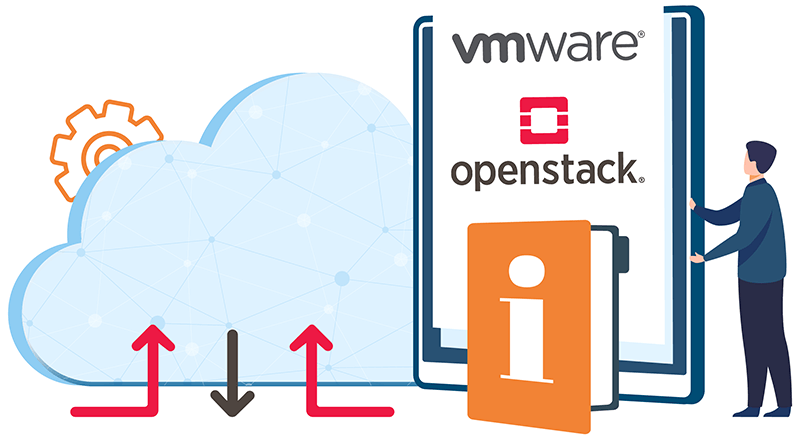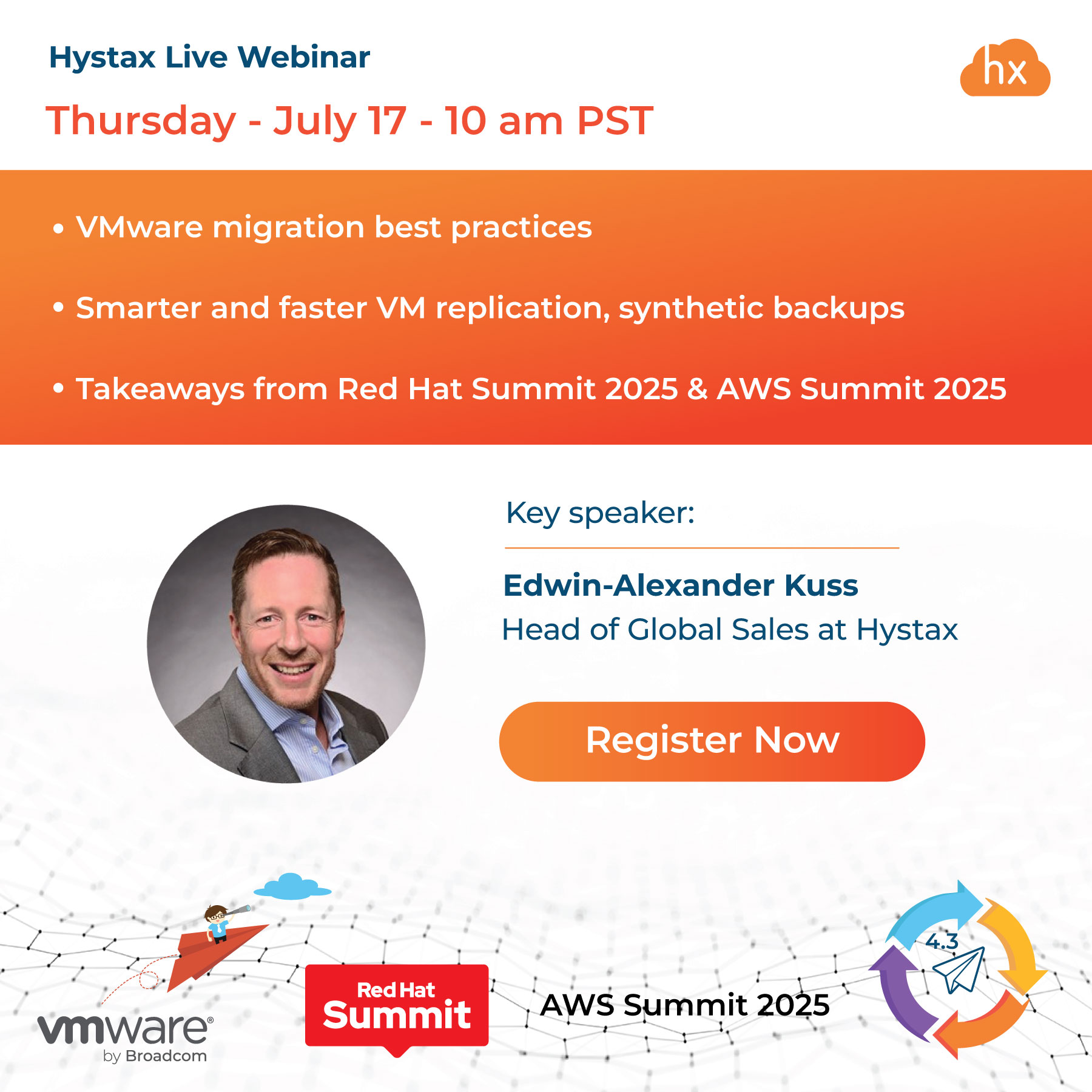
Navigating the cloud landscape: a comparative analysis of OpenStack and VMware for the seamless VM migration
In cloud infrastructure, OpenStack and VMware stand out as two prominent players, each offering distinct approaches to meet the evolving needs of businesses. OpenStack, an open source cloud operating system, provides a scalable foundation for private and public clouds. On the other hand, VMware, a virtualization giant, boasts a suite of proprietary products, including the bare-metal hypervisor ESXi, IaaS offering vCloud, management interface vCenter, and software-defined networking solution NSX.
While both OpenStack and VMware cater to the demands of hybrid and private cloud environments, they diverge in terms of architecture, ecosystem, and features, with some areas of overlap. The decision between the two hinges on the unique requirements of your business. This article will explore the intricacies of these technologies, shedding light on their differences and offering insights into the seamless migration of virtual machines between OpenStack and VMware.
Introduction to VMware's product portfolio
VMware, a versatile multi-cloud service provider, offers a diverse range of products encompassing desktop and server software, cloud management platforms, and networking and security tools. Among its notable offerings is the vCloud Suite, which is positioned as a direct competitor to OpenStack. This suite acts as a unifying force, integrating internal enterprise IT infrastructures virtualized on VMware with cloud resources deployed at VMware-managed data centers.
- Critical infrastructure considerations: To ensure a robust infrastructure, it is imperative to incorporate redundancy and enhance availability. Additionally, the strategic addition of capacity can significantly improve overall performance. Balancing virtual machines across the cluster based on storage capacity and input/output considerations is fundamental to efficient management.
- vRealize suite and licensing challenges: VMware’s vRealize Suite, a proprietary-source software, requires a software purchase accompanied by licensing costs. This pricing model, determined by Portable License Units (PLUs) and per-CPU charges, can lead to substantial expenses, particularly for clusters with multiple CPUs. The hardware and architecture, designed explicitly for special-purpose hardware like blade servers and storage arrays, contribute to initial and potential long-term operational costs.
- Complexity and consulting services: While initial deployment can be handled independently, the inherent complexity often necessitates consulting services. VMware offers such services at a fixed cost of $400,000. However, deploying the Platform is just the beginning. Ongoing maintenance becomes a daily responsibility, and with VMware lacking managed services for vRealize, organizations must recruit and train dedicated staff, introducing unpredictability to operational costs.
- Support services and total cost of ownership (TCO): Support services, a crucial component for any production environment, follow a pricing model similar to licenses, increasing the Total Cost of Ownership (TCO) with more CPUs in the cluster. Tasks such as platform upgrades and patching against security vulnerabilities contribute to the overall operational complexity and costs associated with VMware’s vRealize Suite. The pricing model and ongoing maintenance underscore the importance of thorough consideration and strategic planning for organizations opting for VMware solutions.
VMware advantages
Feature-rich ecosystem: A robust ecosystem offers advanced features such as High Availability (HA), vMotion, and Distributed Resource Scheduler (DRS), enhancing overall product functionality.
User-friendly GUI: The graphical user interface (GUI) provides an easily navigable platform for straightforward management and operation.
API integration: Utilizing APIs facilitates seamless connections between hypervisors and direct storage, streamlining the efficient management of Virtual Machines (VMs).
Comprehensive support: The widely adopted Platform has extensive technical support and detailed user guides.
VMware disadvantages
High licensing costs: Users incur elevated license fees for various products and Total Cost of Ownership (TCO) expenses related to upgrades and patches.
Staff dependence: The absence of managed vRealize services necessitates a dedicated staff for effective system operation.
Proprietary restriction: The tool operates as a proprietary system, limiting access to everyone except administrators.
Introduction to OpenStack's scalable infrastructure
OpenStack, a massively scalable open source project, is a robust infrastructure platform for developing cloud-aware applications and managing private and public clouds. Comprising individual projects like Nova (compute), Cinder (block storage), and Neutron (networking), OpenStack enables Infrastructure as a Service (IaaS) support for third-party Platform as a Service (PaaS) offerings. Emphasizing an open community approach, OpenStack boasts thousands of members contributing to its design, development, and maintenance.
- Key features and flexibility of OpenStack: OpenStack’s fully functional cloud platform supports diverse functionalities, including providing and orchestrating clouds in a multi-hypervisor environment. It excels in running multi-tier workloads and development tools while accommodating almost all hypervisors, such as ESXi, Xen, KVM, and Hyper-V. Operating as a cloud OS, it effectively organizes, provisions, and manages resource pools. The distribution of control, storage, and network among cluster nodes allows uniform hardware specifications on all physical machines in the cluster, optimizing resource utilization.
- Canonical’s support and pricing model: Canonical adopts a per-node model for support services related to Charmed OpenStack, providing predictability to operational expenses. Under the Ubuntu Advantage for Infrastructure (UA-I) package, the most comprehensive support version, Advanced, costs $1,500 annually per physical server. Canonical’s consulting services offer reasonable rates, with the Private Cloud Build package providing hardware guidance, access to reference architecture, and a two-week delivery at prices ranging from $75,000 to $150,000, depending on the environment’s complexity. Recognizing the challenges of OpenStack operations, Canonical offers fully managed services at $4,275 per physical server per year, covering support as the sole regular post-deployment cost.
- OpenStack’s cost-efficiency and open source nature: OpenStack stands out for its compatibility with regular hardware and hyper-converged architecture, leading to uniform hardware specifications across all cluster nodes. This design reduces hardware purchase costs and ensures optimal resource utilization. As an open source software available under the Apache License, OpenStack is free to use, and even when deployed through distributions like Charmed OpenStack, vendors are prohibited from adding additional licensing costs. Canonical, offering its OpenStack distribution at no price, encourages customers to invest in consulting, support, and managed services while keeping the software accessible without licensing fees.
OpenStack advantages
Global vendor support: Support from international vendors of Original Equipment Manufacturers (OEMs) or Operating Systems (OS) ensures interoperability with numerous APIs.
Hypervisor integration: Easy integration with multiple hypervisors allows leveraging existing Infrastructure efficiently.
Cost-effective hardware: Lower hardware purchase requirements and costs make the Platform economically advantageous.
Customization and deployment flexibility: An open-source platform allows users to customize and deploy without restrictions.
Vendor independence: The absence of vendor lock-in allows users to choose and switch between different vendors.
User-friendly resource provisioning: End users can quickly provision resources, contributing to a more streamlined operational process.
OpenStack disadvantages
Usability and feature challenges: Users may face difficulties with user-friendliness and may encounter feature completeness issues.
CLI configuration complexity: Configurations can be intricate when performed through the Command Line Interface (CLI).
Troubleshooting complexity: Troubleshooting and management may pose challenges due to the open-source nature of the Platform.
Conclusion
OpenStack’s inherent open source nature generally results in lower costs for its initial deployment and ongoing operations than VMware. Canonical’s Charmed OpenStack distribution takes cost-effectiveness further by employing a per-node support model, utilizing hyper-converged architecture, and providing consulting, support, and managed services at a reasonable price. This approach significantly reduces costs by an entire order of magnitude.
In comparing VMware and OpenStack, each has distinct advantages and disadvantages. To maximize the benefits, VMware introduced VMware Integrated OpenStack (VMware VIO), a VMware-supported OpenStack distribution designed for businesses to establish and maintain a private cloud atop their vSphere Infrastructure.
🌟 If you consider transferring its data, applications, databases, and IT operations to OpenStack, VMware, or any other cloud from any source platform, Hystax Acura is a fully-automated, reliable, versatile solution to migrate all your workloads and business applications seamlessly and with no downtime.



